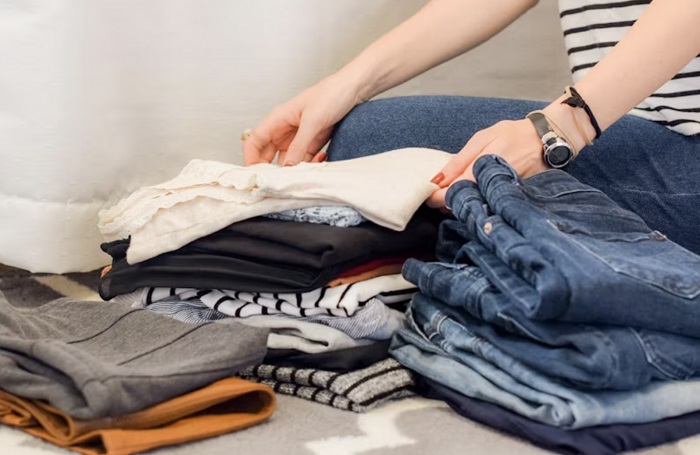If your towels feel more like sandpaper than a soft hug, you’re not imagining things. Towels lose their fluffiness for one reason: bad laundry habits. The good news? You don’t need to buy new ones. You just need to break the cycle that’s flattening and hardening the fibers. Here’s how to fix your towels—and keep them soft for good.
Why Towels Go Flat and Crunchy
There are a few main reasons towels lose their softness:
- Detergent buildup
- Fabric softener residue
- Hard water minerals
- Overdrying
- Not being washed correctly
What feels like “wear and tear” is really just poor maintenance. Towels are made to last, but only if you wash them the right way. Most people destroy theirs without realizing it.
Step 1: Strip Them Clean
Before you do anything else, strip your towels. This removes years of built-up detergent, softener, body oils, and hard water residue. Here’s how:
- Fill a bathtub or large container with hot water
- Add ¼ cup washing soda, ¼ cup borax, and a small scoop of powder detergent
- Soak your towels for 4–6 hours (stir occasionally)
- Rinse thoroughly, then wash normally with no detergent
You’ll be disgusted by the gray water left behind—but your towels will thank you.
Step 2: Stop Using Fabric Softener
This is the number one towel killer. Fabric softener leaves a waxy coating that makes towels feel soft at first but destroys absorbency over time. It builds up with every wash, trapping oils and creating a stiff texture.
Instead, use white vinegar. Add ½ cup to the rinse cycle. It softens towels naturally and removes any leftover detergent.
Step 3: Use Less Detergent
More detergent doesn’t mean cleaner towels. In fact, it leads to buildup and residue that stiffens the fabric. Use about half the amount you think you need, especially in high-efficiency machines.
Look for a detergent with no dyes, perfumes, or additives. Towels don’t need scent—they need rinsing power.
Step 4: Wash on Hot
Unlike most clothes, towels love hot water. It kills bacteria, breaks down body oils, and helps clean out detergent residue. Use the hottest water your machine allows, unless the label says otherwise.
Do this every few washes—even if you’re usually a cold-wash-only person.
Step 5: Skip Overloading the Machine
Stuffing your washer full doesn’t clean towels faster—it just stops them from getting clean at all. Towels need room to move, absorb water, and rinse properly. Wash them in smaller loads for the best results.
Same goes for the dryer—don’t overpack it. Overcrowded dryers leave towels damp and crunchy.
Step 6: Dry Properly
Overdrying is a huge cause of stiff towels. Too much heat literally bakes the fibers. Here’s what to do instead:
- Use medium heat (not high)
- Toss in a couple of wool dryer balls
- Remove towels as soon as they’re dry
- Shake them out before folding
The dryer balls fluff towels and reduce drying time without chemicals. Skipping high heat saves the fabric.
Step 7: Soften Hard Water Impact
If you live in a hard water area, the minerals in your water are killing your towels. They bind with detergent and stick to fibers, making them feel stiff and rough.
Fix this with:
- ½ cup of white vinegar in the rinse cycle
- Regular stripping (every couple of months)
- Water softener tablets or filters in extreme cases
Soft water = soft towels.
Step 8: Wash Towels Separately
Don’t mix towels with clothes. Clothes create lint, tangle with loops, and don’t dry evenly. Wash towels together—ideally by color—to keep them in the best shape.
Also, never wash them with items like jeans, zippers, or hooks. One snag and your towel is toast.
Step 9: Hang Them Right
After every use, hang towels fully open so they can dry fast. Wadded or bunched-up towels trap moisture, which leads to mildew and permanent stink. That “clean but smells gross” problem? It starts in your bathroom, not the laundry room.
Step 10: Rotate and Replace
Even with perfect care, towels have a shelf life. If they’ve gone totally flat, have holes, or no longer absorb water, they’re done. But you can delay that by rotating your towels and using each one less often. Keep a few extras on hand so each towel gets a break between uses.
How Often Should You Wash Towels?
General rule: every 3–4 uses. More if you’re sweaty, sick, or using them after workouts. Less if it’s decorative or barely used. But the key is to wash properly when you do—not just toss them in with your shirts and hope for the best.
Bonus: Quick Refresh Without Washing
Need soft towels but don’t have time to run a full cycle? Toss them in the dryer with a damp washcloth and two wool dryer balls for 10 minutes. It fluffs them up and freshens the smell fast.
Professional Help If You’re Done Trying
Sometimes, the towels feel beyond saving—or you just can’t be bothered. In that case, use trusted laundry in London to handle them for you. They use commercial machines, proper cleaning agents, and know how to restore softness that home machines can’t match.
Final Word: It’s Not Too Late
Even crunchy, stiff, old towels can bounce back if you strip out the buildup and wash them right. Ditch the softeners, wash hot, use vinegar, and dry them properly. Fluffy towels aren’t just about feel—they’re about doing laundry right.














Leave a Reply